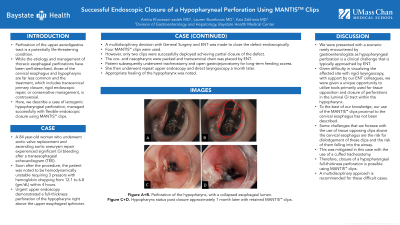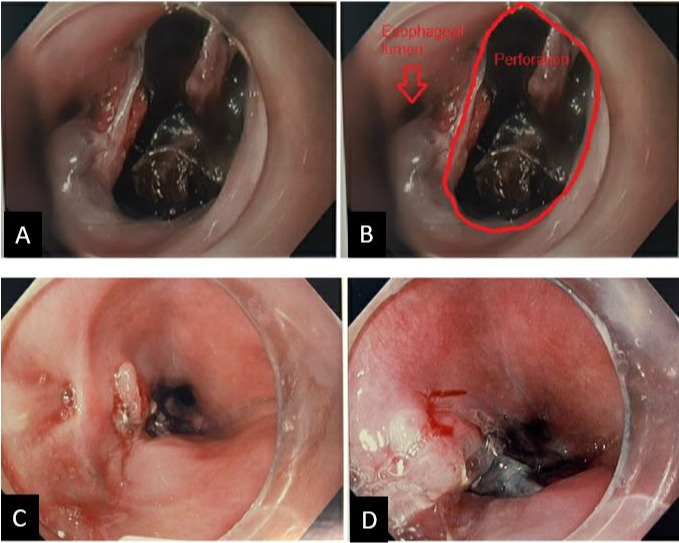Monday Poster Session
Category: Interventional Endoscopy
P2338 - Successful Endoscopic Closure of an Iatrogenic Hypopharyngeal Perforation Using MANTIS™ Clips
Monday, October 23, 2023
10:30 AM - 4:15 PM PT
Location: Exhibit Hall

Has Audio
.jpg)
Arshia Khorasani-Zadeh, MD
UMass Chan-Baystate
Springfield, MA
Presenting Author(s)
Award: Presidential Poster Award
Arshia Khorasani-Zadeh, MD1, Lauren Busekroos, MD2, Kais Zakharia, MD1
1UMass Chan-Baystate, Springfield, MA; 2UMass-Baystate, Springfield, MA
Introduction: Perforation of the upper aerodigestive tract is a potentially life-threatening condition. While the etiology and management of thoracic esophageal perforations have been well described, those of the cervical esophagus and hypopharynx are far less common and the treatment, which includes transcervical primary closure, rigid endoscopic repair or conservative management, is controversial. Here, we describe a case of iatrogenic hypopharyngeal perforation, managed successfully with flexible endoscopic closure using MANTIS™ clips.
Case Description/Methods: 84-year-old female who underwent aortic valve replacement and ascending aortic aneurysm repair complicated by significant GI bleeding after a transesophageal echocardiogram (TEE). Soon after surgery patient was noted to be hemodynamically unstable requiring 3 pressors with hemoglobin dropping from 12.1 to 6.8 (gm/dL) within 4 hours. Urgent endoscopy demonstrated a full-thickness perforation of the hypopharynx right above the upper esophageal sphincter (UES). A multidisciplinary decision (with surgery and ENT) was made to close the defect endoscopically. Four MANTIS™ clips were used however two clips were successfully deployed achieving partial closure of the defect. The oro- and nasopharynx were packed and transcervical drain was placed by ENT. Patient underwent tracheostomy and open Gastro-Jejunal tube placement for long-term feeding access. Patient underwent repeat endoscopy and direct laryngoscopy a month later. Appropriate healing of the hypopharynx was noted.
Discussion: We were presented with a scenario rarely encountered by gastroenterologists as hypopharyngeal perforation is a clinical challenge that is typically approached by ENT. Given difficulty in visualizing the affected site with rigid laryngoscopy, with support by our ENT colleague, we were given a unique opportunity to utilize tools primarily used for tissue opposition and closure of perforations in the luminal GI tract within the hypopharynx. To the best of our knowledge, our use of the MANTIS™ clips proximal to the cervical esophagus has not been described. Some challenges that we foresee with the use of tissue opposing clips above the cervical esophagus are the risk for dislodgement of these clips and the risk of them falling into the airway. This was mitigated in this case with the use of a cuffed tracheostomy. Therefore, closure of a hypopharyngeal full thickness perforation is possible using MANTIS™ clips. A multidisciplinary approach is recommended for these difficult cases.

Disclosures:
Arshia Khorasani-Zadeh, MD1, Lauren Busekroos, MD2, Kais Zakharia, MD1. P2338 - Successful Endoscopic Closure of an Iatrogenic Hypopharyngeal Perforation Using MANTIS™ Clips, ACG 2023 Annual Scientific Meeting Abstracts. Vancouver, BC, Canada: American College of Gastroenterology.
Arshia Khorasani-Zadeh, MD1, Lauren Busekroos, MD2, Kais Zakharia, MD1
1UMass Chan-Baystate, Springfield, MA; 2UMass-Baystate, Springfield, MA
Introduction: Perforation of the upper aerodigestive tract is a potentially life-threatening condition. While the etiology and management of thoracic esophageal perforations have been well described, those of the cervical esophagus and hypopharynx are far less common and the treatment, which includes transcervical primary closure, rigid endoscopic repair or conservative management, is controversial. Here, we describe a case of iatrogenic hypopharyngeal perforation, managed successfully with flexible endoscopic closure using MANTIS™ clips.
Case Description/Methods: 84-year-old female who underwent aortic valve replacement and ascending aortic aneurysm repair complicated by significant GI bleeding after a transesophageal echocardiogram (TEE). Soon after surgery patient was noted to be hemodynamically unstable requiring 3 pressors with hemoglobin dropping from 12.1 to 6.8 (gm/dL) within 4 hours. Urgent endoscopy demonstrated a full-thickness perforation of the hypopharynx right above the upper esophageal sphincter (UES). A multidisciplinary decision (with surgery and ENT) was made to close the defect endoscopically. Four MANTIS™ clips were used however two clips were successfully deployed achieving partial closure of the defect. The oro- and nasopharynx were packed and transcervical drain was placed by ENT. Patient underwent tracheostomy and open Gastro-Jejunal tube placement for long-term feeding access. Patient underwent repeat endoscopy and direct laryngoscopy a month later. Appropriate healing of the hypopharynx was noted.
Discussion: We were presented with a scenario rarely encountered by gastroenterologists as hypopharyngeal perforation is a clinical challenge that is typically approached by ENT. Given difficulty in visualizing the affected site with rigid laryngoscopy, with support by our ENT colleague, we were given a unique opportunity to utilize tools primarily used for tissue opposition and closure of perforations in the luminal GI tract within the hypopharynx. To the best of our knowledge, our use of the MANTIS™ clips proximal to the cervical esophagus has not been described. Some challenges that we foresee with the use of tissue opposing clips above the cervical esophagus are the risk for dislodgement of these clips and the risk of them falling into the airway. This was mitigated in this case with the use of a cuffed tracheostomy. Therefore, closure of a hypopharyngeal full thickness perforation is possible using MANTIS™ clips. A multidisciplinary approach is recommended for these difficult cases.

Figure: Figure A+B: Perforation of the hypopharynx, with a collapsed esophageal lumen
Figure C+D: Hypopharynx status post closure approximately 1 month later with retained MANTIS™ Clip
Figure C+D: Hypopharynx status post closure approximately 1 month later with retained MANTIS™ Clip
Disclosures:
Arshia Khorasani-Zadeh indicated no relevant financial relationships.
Lauren Busekroos indicated no relevant financial relationships.
Kais Zakharia indicated no relevant financial relationships.
Arshia Khorasani-Zadeh, MD1, Lauren Busekroos, MD2, Kais Zakharia, MD1. P2338 - Successful Endoscopic Closure of an Iatrogenic Hypopharyngeal Perforation Using MANTIS™ Clips, ACG 2023 Annual Scientific Meeting Abstracts. Vancouver, BC, Canada: American College of Gastroenterology.

